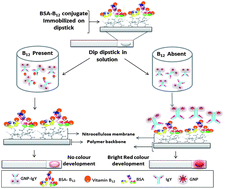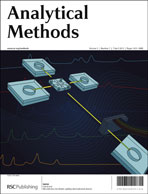Immunodipstick based gold nanosensor for vitamin B12 in fruit and energy drinks†
Abstract
The aim of the work is to develop a gold nanoparticle-based immunodipstick for the rapid detection of vitamin B12 in food samples. The membrane was coated with capturing reagents, that is, Bovine serum albumin–vitamin B12 conjugate and was dipped in different concentrations of vitamin B12 solution containing vitamin B12 IgY antibodies labeled with gold nanoparticles (GNPs). The intensity of color development was inversely proportional to the vitamin B12 concentration with maximum intensity at zero vitamin B12 concentration. The visible detection limit of vitamin B12 was determined to be 1 ng ml−1. GNPs of definite size were synthesized and conjugation efficiency of the GNP–protein conjugates was confirmed qualitatively and quantitatively through gel electrophoresis, flocculation assay, UV-visible, fluorescence spectroscopy, Fourier-transform infrared spectroscopy and transmission electron microscopy. The detection limit of this method is higher than the conventional method, enzyme-linked immunosorbent assay. The results of fruit drinks spiked with 1, 10 and 100 ng ml−1 of vitamin B12 and labeled drinks were in good agreement with those obtained by ELISA. The reproducibility and stability were checked. The simple and non-instrumental dipstick method may further be extended to the screening of other forms of vitamin B12 in food.


 Please wait while we load your content...
Please wait while we load your content...